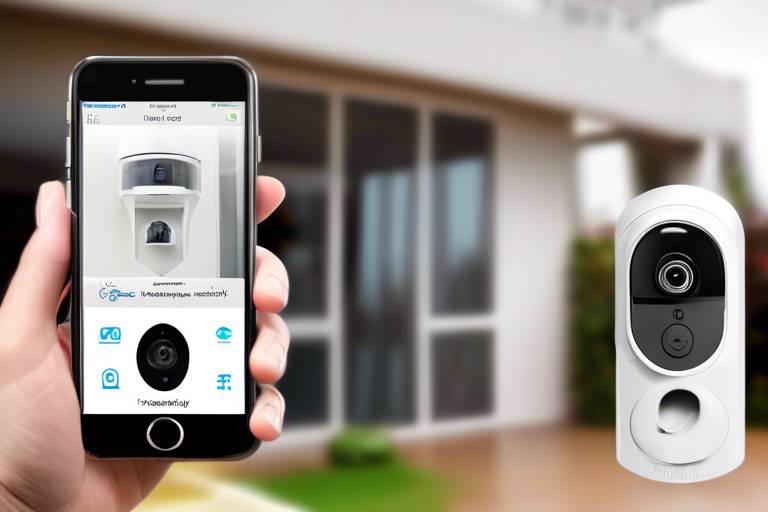The Future of Mobile Application Development
The mobile application development landscape is evolving at breakneck speed, with new trends and technologies emerging almost daily. As we look ahead, it's clear that the future of mobile app development will be shaped by a combination of innovative technologies, changing user expectations, and the ever-growing demand for seamless experiences. Developers, businesses, and users alike must stay informed and adaptable to thrive in this dynamic environment. So, what can we expect in the coming years? Buckle up as we dive into the exciting world of mobile app development!
Innovative technologies like Artificial Intelligence (AI), Augmented Reality (AR), and 5G are transforming mobile app development. These advancements are not just buzzwords; they are enhancing user experiences and creating new opportunities for developers to innovate and engage users effectively. For instance, AI can analyze user behavior to provide personalized recommendations, while AR can immerse users in interactive environments that blend the digital and physical worlds. Meanwhile, the rollout of 5G technology promises lightning-fast connectivity, enabling richer multimedia content and real-time interactions that were previously unimaginable.
User experience (UX) is paramount in mobile app development. As the market becomes increasingly crowded, the need for apps that prioritize user satisfaction and engagement has never been more critical. Developers must focus on creating intuitive interfaces, seamless navigation, and responsive designs that cater to the preferences of their target audience. The goal is to ensure that users not only download the app but also remain engaged over the long term. So, what are the latest trends in UX design? Let's explore!
Personalized experiences are becoming essential in mobile apps. Users today expect apps to understand their preferences and deliver content that resonates with them. By leveraging user data, developers can tailor features and content to individual needs, enhancing engagement and retention. Imagine walking into a coffee shop that knows your favorite drink and has it ready for you before you even order! That's the power of personalization in mobile apps. However, this approach requires a careful balance between delivering value and respecting user privacy.
As personalization increases, so do data privacy concerns. Users are becoming more aware of how their data is used and are demanding transparency from app developers. It's crucial to strike a balance between providing personalized experiences and ensuring robust data protection. Implementing best practices for data privacy, such as anonymizing user data and obtaining explicit consent, is essential for maintaining user trust. Remember, a loyal user base is built on trust!
Incorporating accessibility features is no longer optional; it's a necessity. Designing apps that cater to all users, including those with disabilities, ensures inclusivity and broadens your audience. This means considering various user needs, such as visual impairments, hearing challenges, and cognitive differences. Features like voice commands, screen readers, and adjustable text sizes can make a significant difference. By prioritizing accessibility, developers not only comply with legal standards but also foster a positive user experience for everyone.
Cross-platform development tools are gaining traction, allowing developers to create apps for multiple platforms efficiently. This approach saves time and resources, enabling developers to reach a broader audience without the need to build separate applications for iOS and Android. However, there are challenges associated with cross-platform development, such as performance issues and the need for platform-specific optimizations. Nevertheless, the benefits often outweigh the drawbacks, making it a popular choice for many developers.
As competition grows, effective monetization strategies are crucial for app success. Developers must explore various monetization models to maximize revenue while ensuring user satisfaction. From subscriptions to in-app purchases and advertising, the options are diverse. Understanding the target audience and their preferences can help developers choose the right strategy that aligns with their app's goals.
Subscription models are increasingly popular among mobile apps. This approach allows developers to generate consistent revenue while providing ongoing value to users. By offering tiered subscription plans with exclusive content or features, developers can cater to different user segments and encourage long-term loyalty. Think of it like a streaming service: users pay a monthly fee for access to a library of content, and in return, they receive continuous updates and new offerings.
In-app purchases offer a lucrative monetization avenue. By integrating these purchases seamlessly, developers can enhance user experience while driving revenue growth. Whether it's unlocking premium features, purchasing virtual goods, or accessing exclusive content, in-app purchases can significantly boost an app's profitability. However, it's essential to strike a balance; users should feel that they are getting value for their money, rather than being bombarded with constant prompts to spend more.
- What are the key technologies shaping mobile app development? Emerging technologies like AI, AR, and 5G are at the forefront of mobile app development, enhancing user experiences and enabling innovative features.
- How important is user experience in mobile apps? User experience is critical; it can determine whether users engage with your app or abandon it. Prioritizing UX design is essential for success.
- What are some effective monetization strategies for mobile apps? Popular strategies include subscription models, in-app purchases, and advertising, each offering unique benefits and challenges.

Emerging Technologies
The landscape of mobile application development is undergoing a remarkable transformation, driven by that are reshaping how developers create and users engage with apps. Innovations like Artificial Intelligence (AI), Augmented Reality (AR), and the high-speed connectivity of 5G are not just buzzwords; they are pivotal forces that enhance user experiences and open up new avenues for creativity in app development.
AI is revolutionizing the way apps interact with users. Imagine an app that learns from your behavior, adapting its features and content to suit your preferences. This capability not only makes the app more intuitive but also significantly increases user satisfaction. For instance, AI can help in personalizing recommendations, automating tasks, and even providing real-time customer support through chatbots. The integration of AI leads to a more engaging and efficient user experience, making it a game-changer in the mobile app arena.
Meanwhile, AR is taking user engagement to the next level by blending the digital and physical worlds. Think about how apps like Pokémon Go captivated millions by allowing users to interact with virtual elements in real-world settings. This technology offers developers the chance to create immersive experiences that captivate users and keep them coming back for more. Whether it's through virtual try-ons for retail apps or interactive gaming experiences, AR is paving the way for innovative applications that were once the stuff of science fiction.
On the other hand, the rollout of 5G technology is set to revolutionize mobile app performance. With significantly faster download speeds and reduced latency, 5G enables apps to handle larger data loads and deliver richer content without lag. This means that developers can push the boundaries of what apps can do, from high-definition video streaming to real-time multiplayer gaming. The enhanced connectivity will not only improve user experiences but also allow for more complex functionalities within apps.
As we delve deeper into these technologies, it's essential to consider how they interconnect. For instance, combining AI with AR can lead to personalized augmented experiences that respond to user preferences in real-time. Similarly, the speed of 5G can empower AI algorithms to process vast amounts of data instantaneously, making mobile apps smarter and more responsive than ever before.
In summary, the future of mobile application development is bright, fueled by the synergy of AI, AR, and 5G. These technologies not only enhance user engagement but also empower developers to innovate in ways we have yet to fully imagine. As we move forward, embracing these trends will be crucial for businesses and developers aiming to stay ahead in a competitive market.

User Experience Trends
In the fast-paced world of mobile application development, user experience (UX) has emerged as a critical factor that can make or break an app's success. Developers are now more focused than ever on creating engaging and intuitive experiences that captivate users from the moment they download an app. As we dive into the latest trends shaping UX design, it's essential to understand that the ultimate goal is to ensure user satisfaction and retention in an increasingly competitive landscape.
One of the most significant trends in UX design is the emphasis on personalization. Users today expect apps to cater to their individual preferences and behaviors. By leveraging data analytics, developers can tailor content and features to meet specific user needs. Imagine walking into a coffee shop where the barista knows your usual order; that’s the kind of personalized experience users crave in their apps. Whether it’s recommending products based on past purchases or suggesting content aligned with user interests, personalization fosters a deeper connection between the user and the app.
However, with great personalization comes great responsibility. As developers strive to enhance user experiences, they must also navigate the complex landscape of data privacy concerns. Users are increasingly aware of how their data is being used, and any misstep can lead to a loss of trust. It's crucial for developers to implement robust data protection measures while still offering personalized experiences. Best practices include transparent user consent processes, anonymizing data, and providing users with control over their information. Balancing personalization with privacy is not just a trend; it’s a necessity in today’s app environment.
Another vital aspect of modern UX design is the incorporation of accessibility features. Designing apps that are inclusive and cater to users with diverse needs is no longer optional—it's essential. Accessibility means ensuring that everyone, regardless of their abilities, can navigate and enjoy the app. This includes features like voice commands, adjustable text sizes, and color contrast options. By prioritizing accessibility, developers not only expand their user base but also demonstrate a commitment to social responsibility.
As we look towards the future, the trend of cross-platform development is gaining momentum. Developers are increasingly utilizing tools that allow them to create apps that function seamlessly across various platforms, such as iOS and Android. This approach not only saves time and resources but also enhances the overall user experience by providing consistency across devices. Users appreciate being able to switch from their phone to their tablet without missing a beat, and developers who embrace this trend are likely to see higher satisfaction rates.
To sum it up, the landscape of mobile app development is continually evolving, with user experience taking center stage. By focusing on personalization, data privacy, accessibility, and cross-platform functionality, developers can create apps that not only meet but exceed user expectations. As we move forward, staying attuned to these trends will be crucial for developers, businesses, and users alike.
- What is the importance of user experience in mobile apps?
User experience is crucial as it directly affects user satisfaction, retention, and overall success of the app. - How can developers personalize user experiences?
Developers can use data analytics to tailor content and features to individual user preferences. - What are some best practices for data privacy?
Implementing transparent consent processes, anonymizing data, and giving users control over their information are essential practices. - Why is accessibility important in app design?
Accessibility ensures that all users, regardless of their abilities, can navigate and enjoy the app, expanding the user base and promoting inclusivity. - What are the benefits of cross-platform development?
Cross-platform development allows for consistent user experiences across devices while saving time and resources for developers.

Personalization
In today's fast-paced digital landscape, has emerged as a game-changer for mobile applications. Imagine walking into your favorite coffee shop and the barista already knows your name and your go-to order. That’s the kind of experience users now expect from their apps. With the wealth of data available, developers have the unique opportunity to create tailored experiences that resonate with individual users. But how exactly does this work? By leveraging data analytics, developers can analyze user behavior, preferences, and interactions to curate content that feels personal and relevant.
For instance, think about how streaming services like Netflix or Spotify suggest shows and music based on your previous views and listens. This not only enhances the user experience but also increases engagement and retention rates. When users feel that an app understands them, they are more likely to return. Here are some strategies developers can employ to maximize personalization:
- Behavior Tracking: By monitoring how users interact with the app, developers can identify patterns and preferences that inform future updates and features.
- Customizable Interfaces: Allowing users to personalize their dashboard or interface can significantly improve user satisfaction. This could mean changing themes, layouts, or even the information displayed.
- Targeted Notifications: Sending personalized notifications based on user activity can drive engagement. For example, reminding a user about a new episode of a show they watched can keep them hooked.
However, while personalization is vital, it brings with it a set of challenges, particularly surrounding data privacy. Users are increasingly aware of how their data is used and shared, making it essential for developers to be transparent about data collection practices. Balancing personalization with privacy is a tightrope walk that requires careful consideration and adherence to regulations like GDPR.
Moreover, developers should implement best practices to ensure data is stored securely and used ethically. This not only builds trust but also fosters a loyal user base. In essence, personalization is not just about delivering tailored content; it’s about creating a safe and enjoyable environment where users feel valued.
As we move forward, the focus on personalization will only intensify. Developers who can effectively harness data to create meaningful, personalized experiences will not only stand out in a crowded market but will also foster deeper connections with their users. In a world where choices are abundant, the apps that can deliver a unique, tailored experience will undoubtedly thrive.
What is personalization in mobile apps?
Personalization in mobile apps refers to the practice of tailoring content, features, and experiences to individual users based on their preferences, behaviors, and interactions within the app.
Why is personalization important for mobile app development?
Personalization enhances user engagement and satisfaction by providing relevant content, which can lead to increased retention rates and user loyalty.
How can developers ensure data privacy while personalizing experiences?
Developers can ensure data privacy by being transparent about data collection practices, adhering to regulations like GDPR, and implementing best practices for secure data storage and ethical usage.
What are some examples of personalization in mobile apps?
Examples include tailored recommendations on streaming services, customizable user interfaces, and targeted notifications based on user activity.

Data Privacy Concerns
In an era where data is often referred to as the new oil, the concerns surrounding data privacy have never been more pronounced, especially in mobile application development. As developers strive to create more personalized experiences, they must tread carefully, ensuring that user data is handled with the utmost care. After all, nobody wants to feel like their personal information is being mishandled or exploited. This delicate balance between personalization and privacy is crucial for maintaining user trust and loyalty.
As mobile apps increasingly rely on user data to tailor experiences, the risk of data breaches and misuse escalates. Users are becoming more aware of their digital footprints, often questioning how their data is collected, stored, and used. This growing awareness has led to a demand for transparency from developers. Users want to know exactly what data is being collected and how it will be utilized. Hence, developers must implement robust data protection measures and communicate these practices clearly to their users.
To effectively address these concerns, developers can adopt several best practices:
- Transparency: Clearly communicate data collection practices in user-friendly language. Users should easily understand what data is collected, why it's collected, and how it's used.
- Consent: Always seek explicit consent from users before collecting their data. This not only builds trust but also complies with various regulations.
- Data Minimization: Collect only the data that is necessary for the app's functionality. Avoid the temptation to gather excessive information that may not be needed.
- Security Measures: Implement strong encryption and security protocols to protect user data from unauthorized access and breaches.
Moreover, with regulations like the General Data Protection Regulation (GDPR) and the California Consumer Privacy Act (CCPA) setting strict guidelines on data usage, developers must stay informed and compliant. These regulations not only protect users but also impose hefty fines on companies that fail to adhere to them. This makes it imperative for developers to integrate privacy by design into their development processes.
In conclusion, as mobile app developers navigate the complex landscape of data privacy, they must prioritize user trust. By being transparent about data practices, obtaining consent, minimizing data collection, and implementing robust security measures, they can create a safer environment for users. Remember, in the world of mobile apps, trust is the currency that keeps users engaged and loyal. So, let’s build apps that not only delight users but also respect their privacy.
- What is data privacy in mobile apps? Data privacy in mobile apps refers to the protection of user information collected and used by the app, ensuring it is handled securely and responsibly.
- Why is data privacy important? Data privacy is crucial for maintaining user trust, complying with legal regulations, and protecting sensitive information from breaches and misuse.
- How can developers ensure data privacy? Developers can ensure data privacy by being transparent about data collection practices, obtaining user consent, minimizing data collection, and implementing strong security measures.

Accessibility Features
In the fast-paced world of mobile application development, are not just an optional add-on; they are a necessity. Imagine a world where everyone, regardless of their abilities, can enjoy the same mobile experiences. This is the vision that drives developers to prioritize accessibility in their apps. By incorporating features that cater to users with disabilities, developers not only enhance user satisfaction but also expand their app's reach to a broader audience.
Accessibility is about removing barriers and ensuring that all users can navigate, understand, and interact with mobile applications seamlessly. This includes integrating features such as voice commands, screen readers, and adjustable text sizes. For instance, voice recognition technology allows users with mobility impairments to control their apps hands-free, while screen readers provide auditory feedback for visually impaired users. These features transform the way users engage with technology, making the digital landscape more inclusive.
Furthermore, it’s essential to consider the principles of universal design when developing mobile applications. Universal design focuses on creating products that are usable by all people, to the greatest extent possible, without the need for adaptation. This approach not only benefits users with disabilities but also enhances the overall user experience for everyone. Here are some key accessibility features that developers should consider:
- Text-to-Speech: Enables content to be read aloud, aiding users with visual impairments.
- Color Contrast Adjustments: Ensures text is easily readable against its background, which is crucial for users with color blindness.
- Alternative Text for Images: Provides descriptions for images, allowing screen readers to convey the content to visually impaired users.
- Keyboard Navigation: Allows users to navigate the app using a keyboard, which is essential for those who cannot use a touchscreen.
Incorporating these features not only demonstrates a commitment to inclusivity but can also improve the app's performance in app stores. Search engines and app stores are increasingly favoring apps that prioritize user experience, including accessibility. This means that by focusing on accessibility, developers can enhance their app's visibility and attract a larger user base.
However, it's crucial to remember that accessibility is not a one-time effort; it requires ongoing attention and updates. As technology evolves, so do user needs. Developers should regularly seek feedback from users with disabilities and stay informed about the latest accessibility standards and guidelines, such as the Web Content Accessibility Guidelines (WCAG). By doing so, they can ensure their apps remain relevant and usable for all.
In conclusion, integrating accessibility features into mobile applications is not just a moral obligation; it’s a smart business strategy. By making apps accessible, developers can tap into a vast market of users, enhance user satisfaction, and ultimately drive greater engagement and loyalty. It's time to embrace accessibility as a fundamental aspect of mobile app development, paving the way for a more inclusive digital world.
What are accessibility features in mobile apps?
Accessibility features are tools and functionalities that help users with disabilities interact with mobile applications. These can include voice commands, text-to-speech options, adjustable text sizes, and more.
Why is accessibility important in mobile app development?
Accessibility is crucial because it ensures that everyone, including users with disabilities, can access and enjoy mobile applications. It also broadens the potential user base and improves overall user satisfaction.
How can developers ensure their apps are accessible?
Developers can ensure accessibility by following guidelines such as WCAG, seeking feedback from users with disabilities, and regularly updating their apps to incorporate new accessibility features and technologies.

Cross-Platform Development
In today's fast-paced digital world, has emerged as a game-changer for mobile application creators. The ability to develop applications that run seamlessly across multiple platforms, such as iOS and Android, not only saves time and resources but also broadens the potential user base significantly. Imagine being able to write your code once and deploy it everywhere, like a magic spell that instantly reaches a wider audience! This is the allure of cross-platform development.
However, it's not all rainbows and butterflies. While the benefits are clear, developers face a unique set of challenges. For instance, the performance of cross-platform apps can sometimes lag behind that of native apps, which are designed specifically for one platform. This can lead to a less-than-optimal user experience, making it crucial for developers to strike a balance between performance and efficiency. But don't worry; there are several tools and frameworks available that can help mitigate these issues.
Some of the most popular cross-platform development frameworks include:
- React Native: Developed by Facebook, it allows developers to use JavaScript and React to create mobile applications that feel native.
- Flutter: Google's UI toolkit enables developers to build natively compiled applications for mobile, web, and desktop from a single codebase.
- Xamarin: A Microsoft-owned framework that uses C# to create apps for Android and iOS, offering a native look and feel.
Each of these frameworks has its strengths and weaknesses, making it essential for developers to choose the right one based on their project requirements. For example, if you're looking for a fast development cycle and a rich user interface, Flutter might be the way to go. On the other hand, if your team is already well-versed in JavaScript, then React Native could be a perfect fit.
Moreover, cross-platform development allows for cost efficiency. By reducing the need to create separate codebases for different platforms, businesses can allocate their resources more effectively. This is particularly beneficial for startups and small businesses that might not have the budget for extensive app development. With a single development cycle, they can launch their app sooner and start gaining traction in the market.
However, developers must also consider the impact of user experience when opting for cross-platform solutions. While the goal is to create an app that works on multiple devices, it's important to ensure that the app feels intuitive and responsive, regardless of the platform. This means paying attention to platform-specific design guidelines and user interface conventions. After all, a well-designed app can make the difference between a user who sticks around and one who uninstalls it after a day.
In conclusion, cross-platform development is revolutionizing the way we think about mobile app creation. It offers a unique blend of flexibility, cost-effectiveness, and broader reach. As technology continues to evolve, it will be fascinating to see how developers adapt and innovate within this space. The future is bright for cross-platform development, and those who embrace it will likely find themselves at the forefront of the mobile app revolution.
Q1: What is cross-platform development?
Cross-platform development refers to the practice of creating applications that can run on multiple operating systems, such as Android and iOS, from a single codebase.
Q2: What are the benefits of cross-platform development?
The primary benefits include cost efficiency, faster development times, and the ability to reach a wider audience without having to develop separate apps for different platforms.
Q3: Are cross-platform apps slower than native apps?
Generally, cross-platform apps can experience performance issues compared to native apps. However, advancements in frameworks like Flutter and React Native are bridging this gap significantly.
Q4: Which frameworks are best for cross-platform development?
Popular frameworks include React Native, Flutter, and Xamarin, each with its own strengths and suitable use cases depending on the project's requirements.

Monetization Strategies
As the mobile app market continues to burgeon, developers and businesses are constantly on the lookout for effective to ensure their apps not only survive but thrive in a sea of competition. With millions of apps available, it's crucial to implement strategies that not only generate revenue but also enhance user satisfaction. Let’s dive into some of the most popular monetization models that are making waves in the industry today.
One of the most prevalent strategies is the use of subscription models. This approach allows users to access premium features or content for a recurring fee, providing developers with a steady stream of income. Think of it like a gym membership; users pay a monthly fee to maintain access to the facilities, and in return, they get to enjoy the benefits without the hassle of a one-time purchase. This model not only fosters user loyalty but also encourages developers to continuously improve their offerings to justify the ongoing cost. A recent survey indicated that over 30% of mobile apps now utilize subscription-based pricing, highlighting its growing popularity.
Another lucrative avenue is through in-app purchases. This model allows users to download the app for free, but offers additional features, content, or virtual goods for a price. Imagine playing a game where you can unlock special characters or levels; that's the essence of in-app purchases. They can be seamlessly integrated into the app, ensuring that users feel engaged and motivated to spend without feeling pressured. However, it's essential to strike the right balance here. Overloading users with purchase prompts can lead to frustration and ultimately drive them away. Instead, developers should focus on providing genuine value through these purchases, enhancing the overall user experience while driving revenue growth.
It's also worth considering advertising as a monetization strategy. Many apps opt for ad placements as a way to generate income while keeping the app free for users. However, not all advertising methods are created equal. Developers can choose between various types of ads, such as banner ads, interstitial ads, or native ads, each with its unique advantages and challenges. The key is to ensure that ads are integrated in a way that doesn't disrupt the user experience. For instance, displaying a banner ad at the bottom of the screen may be less intrusive than a full-screen interstitial ad that appears unexpectedly. A well-thought-out advertising strategy can lead to a win-win situation for both developers and users.
To summarize, the landscape of mobile app monetization is diverse and ever-evolving. Developers have a range of strategies at their disposal, including:
- Subscription Models: Generating recurring revenue through premium features.
- In-App Purchases: Offering additional content or features for a price.
- Advertising: Monetizing through ad placements while maintaining user engagement.
By carefully selecting and implementing these strategies, developers can not only maximize their revenue potential but also create a more engaging and enjoyable experience for users. The future of mobile app monetization is bright, and with the right approach, developers can ensure their apps stand out in a crowded marketplace.
- What is the best monetization strategy for mobile apps?
There isn't a one-size-fits-all answer. The best strategy depends on your app's target audience, type of content, and user engagement levels. Many successful apps combine multiple strategies for optimal results.
- How can I ensure my in-app purchases are successful?
Focus on providing real value that enhances the user experience. Offer exclusive content or features that users genuinely want, and ensure that prompts for purchases feel organic within the app.
- Are subscription models worth it?
Yes, subscription models can be highly effective as they provide a steady revenue stream and foster ongoing user engagement, but they require continuous updates and improvements to keep users subscribed.

Subscription Models
Subscription models have emerged as a powerful and sustainable way for mobile applications to generate revenue while delivering ongoing value to users. Think about it: just like a good Netflix binge, where you get access to a treasure trove of content for a monthly fee, mobile apps are now adopting similar strategies to keep users engaged and coming back for more. This model not only provides developers with a steady stream of income but also allows users to enjoy premium features without the burden of hefty one-time payments.
One of the key advantages of subscription models is the ability to foster a long-term relationship between the app and its users. By offering tiered subscription plans, developers can cater to different user needs and preferences. For instance, a fitness app might offer a basic free version with limited features, while the premium subscription could unlock personalized workout plans, nutrition tracking, and even virtual coaching. This tiered approach allows users to choose what best fits their lifestyle and budget, enhancing their overall experience.
Moreover, subscription models can significantly reduce churn rates. When users commit to a subscription, they are more likely to engage consistently with the app to maximize their investment. This is where the magic of continuous updates and feature enhancements comes into play. Developers must keep the content fresh and exciting, offering new features or exclusive content regularly to justify the subscription cost. For example, a language-learning app could introduce new courses and interactive content each month, keeping users motivated and eager to learn.
However, the success of subscription models hinges on effective marketing and user education. Developers need to clearly communicate the value of their subscription offerings. Users must understand what they gain by subscribing versus using a free version. This can be achieved through targeted marketing campaigns, in-app prompts, and even free trials that allow potential subscribers to experience the premium features firsthand. For instance, a gaming app might offer a free week of premium access, allowing players to experience exclusive levels and features before deciding to subscribe.
To illustrate the impact of subscription models, consider the following table that outlines different types of subscription strategies:
| Subscription Type | Description | Examples |
|---|---|---|
| Freemium | Basic features are free, with premium features available for a fee. | Spotify, Duolingo |
| Tiered Subscriptions | Multiple subscription levels with varying features and pricing. | Netflix, Adobe Creative Cloud |
| Pay-Per-Use | Users pay for specific features or content they use. | Amazon Kindle Unlimited, certain fitness apps |
In conclusion, subscription models are not just a passing trend; they represent a fundamental shift in how mobile apps engage with users. By focusing on delivering continuous value and fostering a strong user relationship, developers can create sustainable revenue streams while enhancing user satisfaction. The key is to strike the right balance between offering compelling content and maintaining transparent communication about the benefits of subscribing. After all, a happy user is a loyal user, and loyalty is the cornerstone of any successful subscription model.
- What is a subscription model in mobile apps?
A subscription model allows users to pay a recurring fee to access premium features or content within an app, rather than making a one-time purchase. - How can developers effectively market their subscription services?
Developers can use targeted marketing campaigns, in-app promotions, and free trials to showcase the value of their subscription offerings. - What are the benefits of using a subscription model?
Subscription models provide steady revenue, reduce churn rates, and allow for continuous engagement with users through regular updates and new features.

In-App Purchases
In-app purchases (IAPs) have revolutionized the way mobile apps generate revenue. Instead of relying solely on upfront fees, developers can now offer a free or low-cost app that entices users with the option to unlock additional features, content, or functionalities through IAPs. This model not only enhances user engagement but also allows developers to create a sustainable income stream. Imagine walking into a store where you can browse all the products for free, but if you want that shiny new gadget or exclusive service, you simply pay for it. That’s the essence of in-app purchases!
There are several types of in-app purchases that developers can implement, each offering unique advantages. These include:
- Consumables: Items that can be purchased and used up, like extra lives in a game or in-game currency. Once consumed, users can buy them again.
- Non-consumables: Permanent upgrades or features that enhance the app experience, such as ad removal or premium content that users can access indefinitely.
- Subscriptions: Recurring payments for ongoing access to content or services, ideal for apps offering regularly updated features or content, like streaming services or fitness apps.
Integrating in-app purchases effectively requires a strategic approach. Developers must ensure that the purchase options are enticing and provide real value to the user. For instance, if a game offers a special character or level that can only be accessed through an IAP, it should be compelling enough to encourage users to make that purchase without feeling pressured. The key is to strike a balance between monetization and user satisfaction, ensuring that the app remains enjoyable without overwhelming users with constant prompts to buy.
Moreover, transparency is crucial. Users should always be aware of what they are purchasing and how it enhances their experience. Clear communication about the benefits of IAPs can significantly improve user trust and willingness to spend. A well-placed prompt that highlights the advantages of a purchase can make all the difference. Think of it as a friendly nudge rather than a hard sell.
To further illustrate the impact of in-app purchases, consider the following table that showcases some successful apps utilizing this model:
| App Name | Type of IAP | Annual Revenue |
|---|---|---|
| Fortnite | Consumables & Non-consumables | $1.8 billion |
| Netflix | Subscriptions | $29.7 billion |
| Clash of Clans | Consumables | $1.5 billion |
As we can see, in-app purchases can lead to substantial revenue when implemented thoughtfully. However, developers must remain vigilant about user experience. Overloading users with purchase options can lead to frustration and app abandonment. Instead, focusing on creating a rewarding and engaging experience will encourage users to make those purchases willingly.
In conclusion, in-app purchases are not just a revenue model; they are an integral part of the mobile app ecosystem that, when executed correctly, can enhance user experiences while driving significant profits. The future of monetization in mobile apps lies in balancing user satisfaction with effective revenue strategies, ensuring that both developers and users benefit from the relationship.
- What are in-app purchases? In-app purchases are transactions made within a mobile app to unlock additional features, content, or services.
- How can I implement in-app purchases in my app? You can integrate in-app purchases by using platform-specific APIs provided by app stores, ensuring that you comply with their guidelines.
- Are in-app purchases mandatory for users? No, in-app purchases are optional. Users can still enjoy the basic features of an app without making any purchases.
- What types of in-app purchases are most effective? Consumables, non-consumables, and subscription models can all be effective, depending on the app's nature and target audience.
Frequently Asked Questions
- What are the emerging technologies shaping mobile app development?
Emerging technologies such as Artificial Intelligence (AI), Augmented Reality (AR), and 5G are revolutionizing mobile app development. These innovations enhance user experiences by making apps more interactive and responsive. For instance, AI can analyze user behavior to offer personalized content, while AR provides immersive experiences that engage users in entirely new ways.
- How important is user experience (UX) in mobile app development?
User experience is absolutely crucial in mobile app development. With countless apps available, developers must prioritize UX to keep users satisfied and engaged. Trends like intuitive design and seamless navigation are key to ensuring that users not only download an app but also continue to use it regularly.
- What role does personalization play in mobile apps?
Personalization is becoming a game-changer in mobile apps. By leveraging user data, developers can create tailored experiences that resonate with individual preferences. This not only enhances user engagement but also boosts retention rates, making users feel valued and understood.
- How can developers balance personalization with data privacy?
Balancing personalization with data privacy is essential. Developers should implement best practices for data protection, such as anonymizing user data and ensuring transparency about data usage. This builds trust with users, allowing them to enjoy personalized experiences without compromising their privacy.
- Why are accessibility features important in mobile apps?
Incorporating accessibility features is vital for creating inclusive apps that cater to all users, including those with disabilities. Features like voice commands, screen readers, and adjustable text sizes ensure that everyone can enjoy the app, broadening the user base and enhancing overall user satisfaction.
- What are the benefits of cross-platform development?
Cross-platform development allows developers to create apps that work on multiple platforms, saving time and resources. This approach not only increases reach but also simplifies maintenance and updates, making it an attractive option for developers looking to maximize their impact.
- What monetization strategies can developers use for their apps?
Effective monetization strategies are crucial for app success. Developers can explore various models, such as subscriptions, in-app purchases, and advertising. Each model has its own advantages, and choosing the right one depends on the app's nature and user preferences.
- How do subscription models work in mobile apps?
Subscription models provide a steady stream of revenue by offering users ongoing access to premium content or features for a recurring fee. This approach not only generates consistent income but also encourages developers to continuously improve the app, providing ongoing value to subscribers.
- What are the best practices for integrating in-app purchases?
Integrating in-app purchases should be done seamlessly to enhance user experience. Developers should ensure that the purchase process is straightforward and that users clearly understand the value of what they are buying. Offering free trials or limited-time offers can also encourage users to make purchases.



















